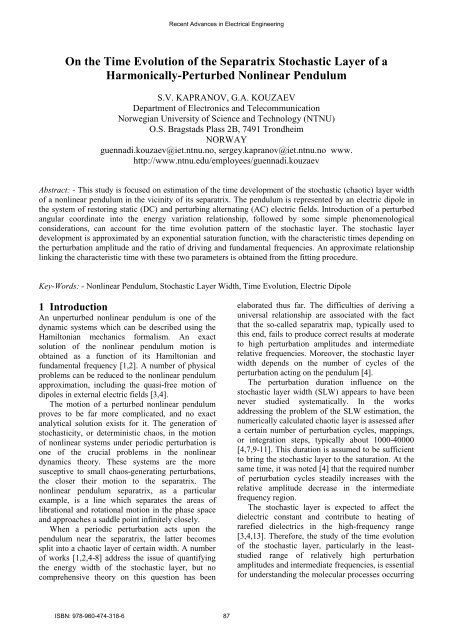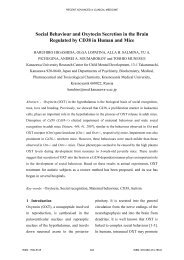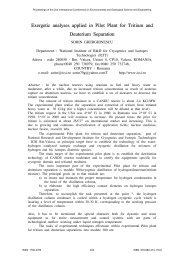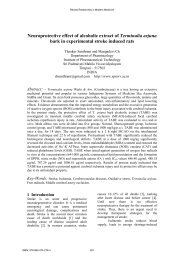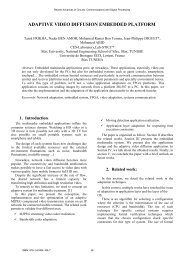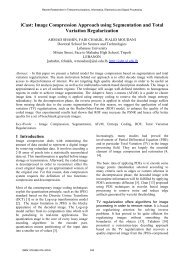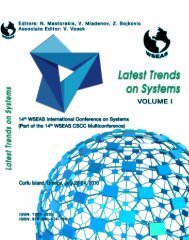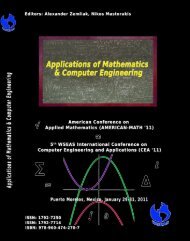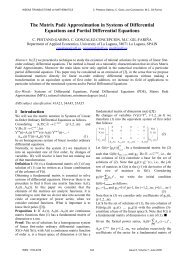On the Time Evolution of the Separatrix Stochastic Layer ... - Wseas.us
On the Time Evolution of the Separatrix Stochastic Layer ... - Wseas.us
On the Time Evolution of the Separatrix Stochastic Layer ... - Wseas.us
You also want an ePaper? Increase the reach of your titles
YUMPU automatically turns print PDFs into web optimized ePapers that Google loves.
Recent Advances in Electrical Engineeringsuch dependences for <strong>the</strong> collinear and transverseperturbations are shown in Fig. 1. The parameters aand b <strong>of</strong> <strong>the</strong> linear relationshipN = aνω0+ b, (18)accumulated for all <strong>the</strong> data sets, are plotted in Fig.2against <strong>the</strong> relative perturbation amplitude є .<strong>On</strong>e can notice two remarkable features in <strong>the</strong>seplots. First, <strong>the</strong> parameters a and b, in <strong>the</strong>ir entirety,look like <strong>the</strong> mirror images <strong>of</strong> each o<strong>the</strong>r, with <strong>the</strong>horizontal reflection plane located somewherebetween 0 and 50. Second, <strong>the</strong>ir absolute valuesappear to oscillate and exponentially decay with є,eventually converging at <strong>the</strong> mirror plane ordinate.<strong>On</strong> <strong>the</strong> basis <strong>of</strong> <strong>the</strong>se considerations, <strong>the</strong> four sets<strong>of</strong> <strong>the</strong> coefficients a and b are fitted <strong>us</strong>ing a functiona1exp ( − a2є) ⎡⎣cos ( a3є)+ a4⎤⎦+ a5where a 1 , a 2 , a 3 , a 4 , a 5 are <strong>the</strong> fit constants.The fit equations for <strong>the</strong> separate groups <strong>of</strong> <strong>the</strong>secoefficients are shown in Fig.2 beside each fit curve.Assuming <strong>the</strong> true mirror arrangement <strong>of</strong> a and b,<strong>the</strong> fit equations for <strong>the</strong> coefficients related to <strong>the</strong>collinear and transverse perturbations are( acol− 14.5) =−( bcol−14.5)(19)= 41.3exp( − 14.8є) ⎡⎣cos( 92.3є)+ 2.9⎤⎦and( atr− 18.0) =−( btr−18.0)(20)= 36.7exp( − 13.1є ) ⎡⎣cos( 92.3є)+ 1.1 ⎤⎦.Fur<strong>the</strong>rmore, <strong>the</strong> similarity <strong>of</strong> <strong>the</strong> panels <strong>of</strong> Fig. 2suggests that <strong>the</strong> time evolution <strong>of</strong> <strong>the</strong> SLW in bothcases is likely to be described by a singlerelationship. The fitting procedure incorporating all<strong>the</strong> four groups <strong>of</strong> <strong>the</strong> coefficients results in( atot− 17.5) =−( btot−17.5)(21)= 39.2exp( − 14.1є ) ⎡⎣cos( 92.0є)+ 2.0 ⎤⎦.If (19)-(20) or (21) are still correct in <strong>the</strong> region<strong>of</strong> weak fields, <strong>the</strong>n <strong>the</strong> characteristic number <strong>of</strong>perturbation cycles is about 20-40 for νω 0 = 1 andinfinitely small amplitude. In <strong>the</strong> area <strong>of</strong> highrelative amplitudes, <strong>the</strong> characteristic number <strong>of</strong>perturbation cycles calculated from (19)-(21) turnsout to be zero. As a matter <strong>of</strong> fact, this physicallymeaningless result implies that <strong>the</strong> number <strong>of</strong> fieldcycles saturating <strong>the</strong> SLW in this region is,expectedly, as low as about unity.Beca<strong>us</strong>e <strong>of</strong> <strong>the</strong> paucity <strong>of</strong> <strong>the</strong> data <strong>us</strong>ed, it is yetunclear whe<strong>the</strong>r <strong>the</strong> obtained equations (19)-(21)can be applied to average <strong>the</strong> influence <strong>of</strong> all initialphases. The broad dispersion <strong>of</strong> <strong>the</strong> coefficientvalues (Fig. 2) suggests that <strong>the</strong> field phase plays animportant role in <strong>the</strong> stochastic layer development.Fig.2 Coefficients <strong>of</strong> (18) vs. <strong>the</strong> relativeperturbation amplitude for <strong>the</strong> collinear (upperpanel) and transverse (lower panel)perturbations. Blue circles and fit lines: a; greensquares and fit lines: b. The fit equations aregiven for each group <strong>of</strong> <strong>the</strong> coefficients.4 Concl<strong>us</strong>ionA phenomenological approach to finding <strong>the</strong> timeevolution <strong>of</strong> <strong>the</strong> stochastic layer <strong>of</strong> a perturbedpendulum dipole has been proposed in this work. Asa result <strong>of</strong> this approach, <strong>the</strong> complete equation (13)and its simplified version (16) have been derived.These equations in principle allow predicting <strong>the</strong>exponential decrease <strong>of</strong> <strong>the</strong> stochastic layerbroadening rate, which has been observed in <strong>the</strong>simulations.The area <strong>of</strong> moderately high perturbationamplitudes and intermediate frequencies studied inthis work is <strong>of</strong> special importance, since no rigoro<strong>us</strong><strong>the</strong>oretical basis was proposed to account for <strong>the</strong>nonlinear pendulum dynamics in this region.In our simulations, <strong>the</strong> characteristic stochasticlayer saturation time, expressed as <strong>the</strong> characteristicISBN: 978-960-474-318-6 90
Recent Advances in Electrical Engineeringnumber <strong>of</strong> perturbation cycles, has been found tovary linearly with <strong>the</strong> relative perturbationfrequency. The coefficients <strong>of</strong> this linear relationconverge in an oscillatory manner to a constantvalue with <strong>the</strong> relative perturbation amplitudeincrease. In <strong>the</strong> zero-field limit, <strong>the</strong> characteristicnumber <strong>of</strong> perturbation cycles has proven to attainsome tens for <strong>the</strong> main resonance frequency. In <strong>the</strong>strong-field limit, <strong>the</strong> fit equations have predicted anear-zero number <strong>of</strong> cycles for this frequency,which is quite reasonable, taking into account <strong>the</strong>strong scattering and uncertainty <strong>of</strong> <strong>the</strong> fittedcoefficients.The found results are interesting in <strong>the</strong>developments <strong>of</strong> enhanced technologies <strong>of</strong>microwave heating and chemistry, and incontrolling molecules by EM field [13].References:[1] B.V. Chirikov, A Universal Instability <strong>of</strong>Many-Dimensional Oscillator Systems, Phys.Rep., Vol.52, No.5, 1979, pp. 263-379.[2] G.M. Zaslavsky, Physics <strong>of</strong> Chaos in HamiltonSystems, Imperial College Press, 1998.[3] S.V. Kapranov, G.A. Kouzaev, <strong>Stochastic</strong>ity inNonlinear Pendulum Motion <strong>of</strong> Dipoles inElectric Field, In: Recent Advances in SystemsEngineering and Applied Ma<strong>the</strong>matics,Selected papers from WSEAS Conference inIstanbul, Turkey, May 27-30, 2008, WSEASPress, 2008, pp. 107-111.[4] S.V. Kapranov, G.A. Kouzaev, <strong>Stochastic</strong>Dynamics <strong>of</strong> Electric Dipole in ExternalElectric Fields: A Perturbed NonlinearPendulum Approach, Physica D, Vol.252,No.1, 2013, pp. 1-21.[5] A.C.J. Luo, R.P.S. Han, The dynamics <strong>of</strong><strong>Stochastic</strong> and Resonant <strong>Layer</strong>s in aPeriodically Driven Pendulum, Chaos, SolitonsFractals, Vol.11, No.14, 2000, pp. 2349-2359.[6] V.V. Vecheslavov, Chaotic <strong>Layer</strong> <strong>of</strong> aPendulum Under Low- and Medium-FrequencyPerturbations, Tech. Phys., Vol.49, No.5, 2004,pp. 1-5.[7] I.I. Shevchenko, The Width <strong>of</strong> a Chaotic <strong>Layer</strong>,Phys. Lett. A, Vol.372, No.6, 2008, pp. 808-816.[8] S.M. Soskin, R. Mannella, Maximal Width <strong>of</strong><strong>the</strong> <strong>Separatrix</strong> Chaotic <strong>Layer</strong>, Phys. Rev. E,Vol.80, No.6, 2009, 066212.[9] A.C.J. Luo, K. Gu, R.P.S. Han, Resonant-<strong>Separatrix</strong> Webs in <strong>Stochastic</strong> <strong>Layer</strong>s <strong>of</strong> <strong>the</strong>Twin-Well Duffing Oscillator, NonlinearDynam., Vol.19, No.1, 1999, pp. 37-48.[10] A.C.J. Luo, R.P.S. Han, Dynamics <strong>of</strong><strong>Stochastic</strong> <strong>Layer</strong>s in Nonlinear HamiltonianSystems, Int. J. Nonlinear Sci. Numer. Simul.,Vol.1, No.2, 2000, pp. 119-132.[11] S.M. Soskin, R. Mannella, O.M. Yevt<strong>us</strong>henko,Matching <strong>of</strong> <strong>Separatrix</strong> Map and ResonantDynamics, with Application to Global Chaos<strong>On</strong>set Between Separatrices, Phys. Rev. E,Vol.77, No.3, 2008, 036221.[12] Ya. Goltser, A. Domoshnitsky, AboutReducing Integro-Differential Equations withInfinite Limits <strong>of</strong> Integration to Systems <strong>of</strong>Ordinary Differential Equations, Adv. Diff.Equ., 2013:187, 2013.[13] G.A. Kouzaev, Applications <strong>of</strong> AdvancedElectromagnetics. Components and Systems.Springer-Verlag, 2013.ISBN: 978-960-474-318-6 91


